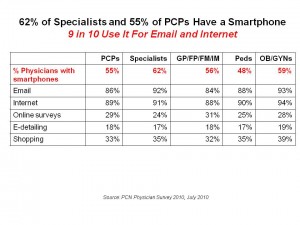 6 in 10 doctors in the U.S. have a smartphone, and most of them use the devices for email and accessing the mobile Internet. These findings come from a survey conducted among members in The Physicians Consulting Network. “Smartphones are quickly becoming a way of life for medical professionals,” PCN observes.
6 in 10 doctors in the U.S. have a smartphone, and most of them use the devices for email and accessing the mobile Internet. These findings come from a survey conducted among members in The Physicians Consulting Network. “Smartphones are quickly becoming a way of life for medical professionals,” PCN observes.
PCN explored physicians’ views on various digital technologies, especially concerning digital health information which is top-of-mind for providers given the window of opportunity to exploit ARRA HITECH incentives for adopting electronic health records (EHRs). This survey found that 50% of PCPs and 52% of specialists keep patient records in an electronic format. The proportion of doctors saying they use electronic patient records ranged from a low of 45% among pediatricians and OB/GYNs to a high of 52% among specialists and GP/FP/FM/IMs. This was also a growing trend since 2008 when PCN surveyed its physician panel, when 38% of PCPs and 42% of specialists said they used electronic formats for patient data.
PCN is part of Knowledge Networks, which conducted the survey among 10,664 members of the PCN panel between April and June 2010.
Health Populi’s Hot Points: There’s no question that smartphones are being adopted by consumers the world over, and across every kind of people, as Robert Palmer would say. Physicians are no different in this regard.
As I wrote in California HealthCare Foundation’s white paper on How Smartphones Are Changing Health Care for Consumers and Providers, smartphones are already mainstream technologies for doctors and patients alike. Beyond being ‘technologies,’ though, it’s the form factor, the ease of use, and the pure delight for many users that drives both adoption and “adherence” to the platform. Apps can be among the most usable programs doctors have ever encountered.
Because of that, the smartphone platform is a no-brainer for many physicians to use in concert with an EHR. Smart developers of EHRs aiming at the bottom of the pyramid of physicians — by that I mean the vast majority of doctors practicing on Main Street in small or solo groups — should pay heed to this phenomenon. Doctors are already using smartphones to meet up with e-detailing with pharmaceutical companies, as well as completing surveys and shopping via mobile. Moving from exam room to exam room, from Grand Rounds to the emergency department, from the surgery suite to the cafeteria is an uber-mobile workstyle. Mobile EHRs via smartphones will be a killer app for physicians.




 Thank you, Jared Johnson, for including me on the list of the
Thank you, Jared Johnson, for including me on the list of the  I am so grateful to Tom Lawry for asking me to pen the foreword for his book, Health Care Nation,
I am so grateful to Tom Lawry for asking me to pen the foreword for his book, Health Care Nation,  Thanks to Feedspot for naming this blog, Health Populi, as a
Thanks to Feedspot for naming this blog, Health Populi, as a